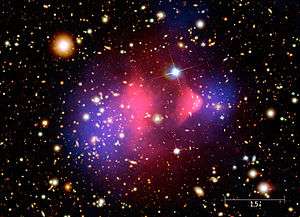DarkSide
The DarkSide collaboration is an international affiliation of universities and labs seeking to directly detect dark matter in the form of weakly interacting massive particles (WIMPs). The collaboration is planning, building and operating a series of liquid argon time projection chambers (TPCs) that are employed at the Gran Sasso National Laboratory in Assergi, Italy. The detectors are filled with liquid argon from underground sources[1] in order to exclude the radioactive isotope 39
Ar, which makes up one in every 1015 (quadrillion) atoms in atmospheric argon.[2] The Darkside-10 (DS-10) prototype was tested in 2012, and the Darkside-50 (DS-50) experiment has been operating since 2013. Darkside-20k (DS-20k) with 20 tonnes of liquid argon is being planned as of 2019.
Darkside-10
The Darkside-10 prototype detector had 10kg of liquid argon. It was built at Princeton University and operated there for seven months, after which it was transported to Gran Sasso National Laboratory in 2011. The detector operated in Gran Sasso 2011-2012.
Status
Darkside-50 has 46 kg argon target mass. A 3-year run is planned and ton-scale expansion has been proposed.
Initial results using a month of running were reported in 2014.[3] Spin-independent limits were set using 1422 kg×days of exposure to atmospheric argon. A cross section limit of 6.1×10−44 cm2 for a 100 Gev WIMP was found.
Members
The following institutions' physics departments include members of DarkSide:
- Augustana College, USA
- Black Hills State University, USA
- Drexel University, USA
- Fermi National Accelerator Laboratory, USA
- The University of Chicago, USA
- Princeton University, USA
- Temple University, USA
- University of Arkansas, USA
- University of California at Los Angeles, USA
- University of California at Davis, USA
- University of Houston, USA
- University of Massachusetts at Amherst, USA
- University of Hawaii, USA
- Virginia Tech, USA
- University College of London, GB
- Royal Holloway, University of London, GB
- INFN – Laboratori Nazionali del Gran Sasso, Italy
- INFN – Università degli Studi di Genova, Italy
- INFN – Università degli Studi di Milano, Italy
- INFN – Università degli Studi di Napoli, Italy
- INFN – Università degli Studi di Perugia, Italy
- INFN – Università degli Studi di Cagliari, Italy
- CERN – The European Organization for Nuclear Research, Switzerland/France
- Jagiellonian University, Cracow, Poland
- Joint Institute for Nuclear Research, Dubna, Russia
- Lomonosov Moscow State University, Russia
- Novosibirsk State University, Russia
- Institute for Nuclear Research of NASU, Kiev, Ukraine
- RRC Kurchatov Institute, Russia
- National Research Nuclear University, Moscow, Russia
- Institute for Theoretical and Experimental Physics, Moscow, Russia
- St. Petersburg Nuclear Physics Institute, Gatchina, Russia
See also
References
- Lofholm, Nancy (5 October 2012). "Colorado argon will be at the heart of dark matter experiment". Denver Post.
- "Low-background Argon from underground reservoir". DarkSide collaboration. Archived from the original on 2016-07-23.
- Agnes, P.; et al. (2015). "First Results from the DarkSide-50 Dark Matter Experiment at Laboratori Nazionali del Gran Sasso". Physics Letters B. 743 (456): 456. arXiv:1410.0653. Bibcode:2015PhLB..743..456A. doi:10.1016/j.physletb.2015.03.012.
Publications
- Akimov, D.; et al. (2012). "Light Yield in DarkSide-10: A Prototype Two-phase Liquid Argon TPC for Dark Matter Searches". arXiv:1204.6218v1 [astro-ph.IM].
- Back, H. O.; et al. (2012). "First Large Scale Production of Low Radioactivity Argon from Underground Sources". arXiv:1204.6024 [astro-ph.IM].
- Back, H. O.; et al. (2012). "First Commissioning of a Cryogenic Distillation Column for Low Radioactivity Underground Argon". arXiv:1204.6061v2 [astro-ph.IM].
- Xu, J.; et al. (2015). "A study of the trace 39Ar content in argon from deep underground sources". Astroparticle Physics. 66: 53–60. arXiv:1204.6011v1. Bibcode:2015APh....66...53X. doi:10.1016/j.astropartphys.2015.01.002.
- Wright, Alex; Mosteiro, Pablo; Loer, Ben; Calaprice, Frank (2011). "A highly efficient neutron veto for dark matter experiments". Nuclear Instruments and Methods in Physics Research Section A. 644 (1): 18–26. arXiv:1010.3609. Bibcode:2011NIMPA.644...18W. doi:10.1016/j.nima.2011.04.009.
- DarkSide Collaboration, “DarkSide-50 Proposal” (2008).
- Galbiati, C.; et al. (2008). "Discovery of underground argon with a low level of radioactive 39Ar and possible applications to WIMP dark matter detectors". Journal of Physics: Conference Series. 120 (4): 042015. arXiv:0712.0381. doi:10.1088/1742-6596/120/4/042015.
